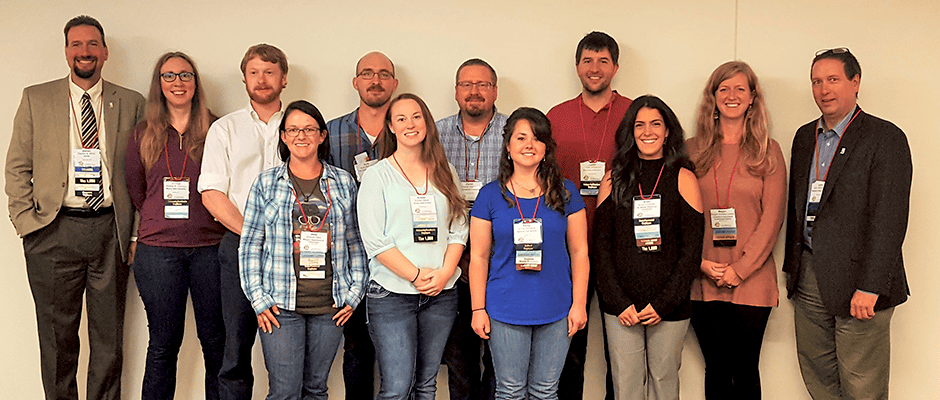Share this article
Leading the pack: An insider’s experience at TWS’s Leadership Institute
This article originally appears in the North Central Section of The Wildlife Society’s Fall 2018 newsletter.
The “why” is something I’ve struggled with for a few years. Why should I or anyone else be involved with The Wildlife Society?
In college, our advisors told us that we should be involved with any professional organization possible because we would get experiences that would help us get jobs. Now that I have a permanent position with a great natural resource agency, the desperation to pad the resume has subsided considerably.
I initially joined the Missouri Chapter of TWS because I felt I should give back, as TWS had given me many opportunities to grow as a student. I had no idea how to convince my peers that they should join and be active members because they had not had the same experiences as I had by being a part of a student chapter. How could I ever be a leader if I couldn’t articulate the importance of joining a professional society? My hope was that going through TWS’s Leadership Institute program would help shed some light on what I was missing.
The LI program is designed to give wildlife professionals a platform to develop and strengthen their leadership skills. The first several months included phone calls, tons of readings and assignments that beckoned our class to explore the habits, skills and traits of ourselves and people we know. The real fun began at The Wildlife Society’s Annual Conference in Cleveland, Ohio this past fall (all expenses paid by TWS!).
At the conference, we discussed the results of these assignments, which allowed us to see how different our experiences and perceptions were regardless of our common interest in conservation. We also had the opportunity to attend TWS Council meetings and mingle with leaders in our organization.
One of the greatest benefits of this process was learning that we all have different skills that enable us to lead in different ways, and that I don’t necessarily have to be the person standing in front of the crowd. I also had several experiences through our assignments that gave insight to how those we distinguish as leaders actually became leaders. They all had a clear vision, did not hesitate to act, encouraged their peers and kept trying in the face of failure.
After interacting with so many passionate individuals at the conference who have poured their lives into TWS, I knew I had been lacking a fundamental concept regarding professional development. I have a theory that this concept is the key to having a long and fulfilling career as a wildlife professional.
I’ve been in this field long enough to have met numerous people at a variety of stages in their careers, and I’ve seen that those who seem to be the most fulfilled by their careers are, without exception, motivated to be involved in something outside their immediate responsibilities. Many are active members of professional organizations such as TWS or are focused on mentoring future generations through organizations like the Boy Scouts of America. What you get out of your career, preferred organization and life is in exact proportion to what you put in. By venturing out of your comfort zone you might stumble upon invaluable knowledge and perspectives that you never anticipated.
My personal leadership philosophy used to be that when an opportunity knocks, I had better open the door. I now know that to be a leader, it’s not enough just to seize the opportunities that fall at your feet. Being a leader is much like being a wolf. You must stalk opportunities as a wolf stalks its prey. You must realize you are not alone and can tackle much bigger prey with a pack. You must find the courage to take risks because risks allow you to learn and thrive, and they can offer significant rewards. Finally, not all leaders have to stand in the spotlight because not all wolves are alphas. Everyone in the pack has an important role to play.
“Believe in yourself. Stay humble. Stay hungry. Be unstoppable.” Ed Thompson, TWS’s chief executive officer, left us with these final words just before our LI class received our certificates. We were at the end of the conference, exhausted in every way possible after five days of meetings, presentations and social events. However, the simple and concise statement left me energized and inspired, and it summarized the lessons I gained from the LI experience. I had zero expectations when applying for this program except to figure out how to recruit for TWS. What I had gained was a whole new perspective of leadership roles, professional development, new professional contacts and new friends.
These are exactly the tools I need to sharpen not only my leadership skills but also the skills of those around me.
Header Image: TWS President Darren Miller, left, and Past President John McDonald, right, join participants in the 2018 Leadership Institute program. Front row (left to right): Jessica Tapp, Kristin Black, Emily Williams, and Kristi Confortin. Back row (left to right): Andrea Darracq, Charles Evans, Kyle McLean, Daniel Greene, Colter Chitwood, Megan Linske.








